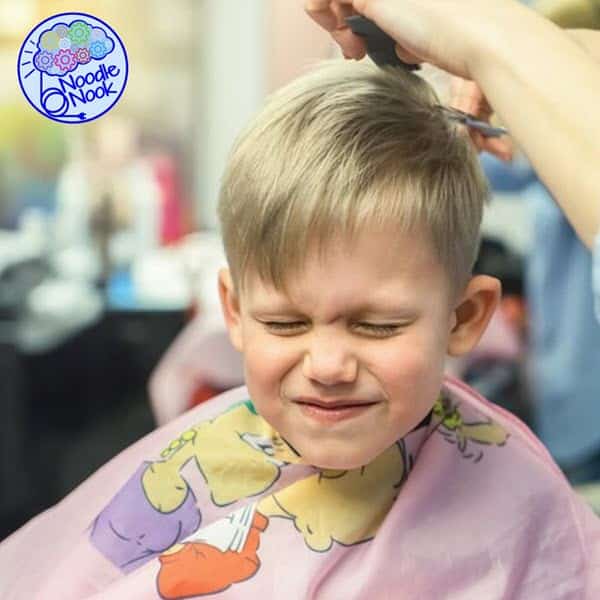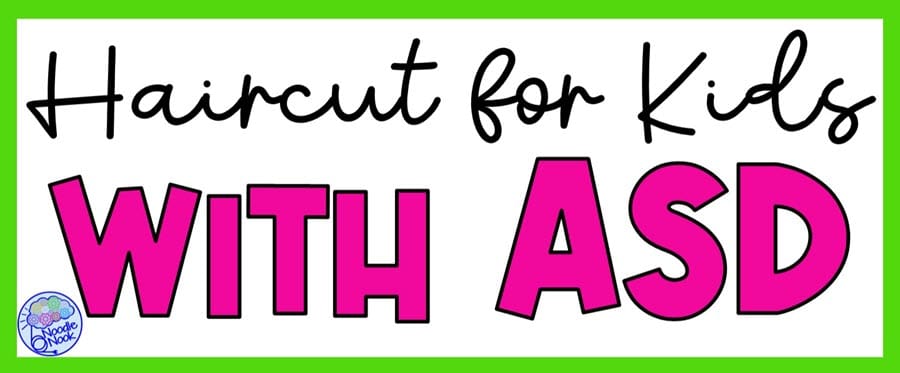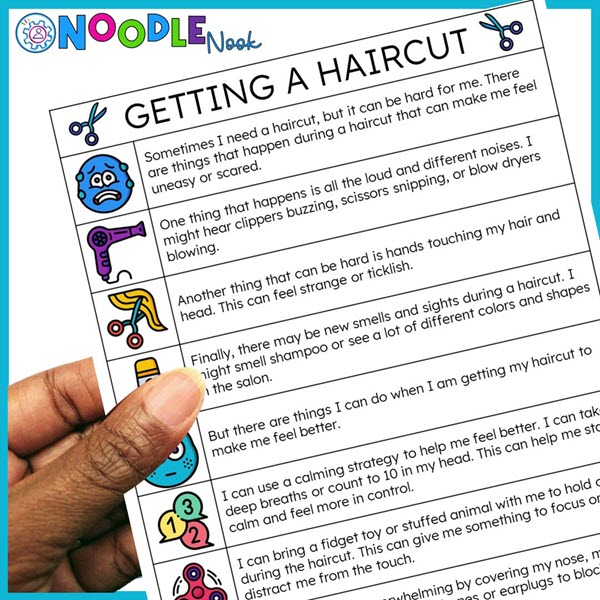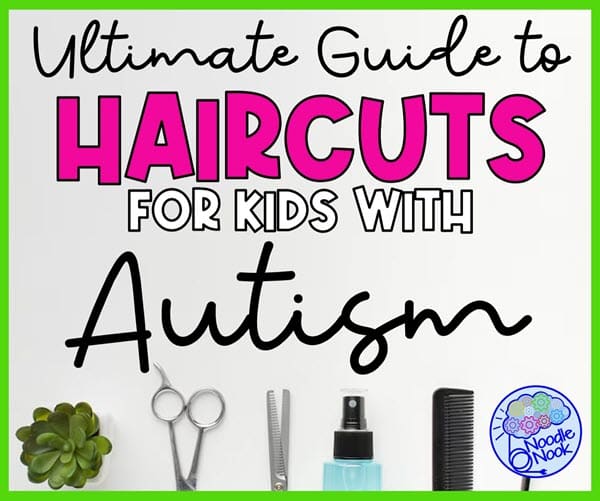For children with autism spectrum disorder (ASD), haircuts can be overwhelming due to their sensory processing issues. The sound of clippers or a blow dryer, the sensation of hair falling on their skin, the feeling of hands on them, or even the chair moving can be too much to handle. Good news is with some preparation and understanding, getting a hair cut for autistic child can be a more comfortable experience. In this post, we’ll be sharing our ultimate guide to haircuts for kids with autism, packed with tips and tricks to help you easily navigate this process.
Understanding Sensory Issues in Kids with ASD
Autistic children often experience sensory overload when they get their hair cut. That can make getting a child’s hair cut a stressful experience for both you and them. You may even put off haircuts for a long time for your own mental health! When it comes to getting a good haircut without the full-blown emotional event, think about the child’s particular situation and needs.
Sensory issues can range from sensitivity to loud noises, discomfort with touch, and difficulty with transitions. For some children, the sound of the clippers or the sensation of hair falling on their skin can be overwhelming and actually cause physical pain. For other autistic people, it’s more about the unfamiliar environment of a hair salon and the new people that can add to their anxiety.
As a parent or caregiver, it’s important to recognize your child’s specific sensory triggers and help them cope with these challenges. For example, if your child is sensitive to loud noises, it may be helpful to schedule the haircut during a quieter time of day or use noise-canceling headphones.
Sam: Hair Cut for Autistic Child

I had a student with autism who was particularly sensitive to touch. When it was time for his haircut, he would become very anxious and visibly upset. Let’s just say it was not the highlight of anyone’s week… or month.
The sound of the clippers made Sam feel uncomfortable, and he had trouble sitting still in the barber chair. His parents realized the sensation of hair falling on his skin was really the biggest challenge. It was made worse because he hated the barber cape that went around his neck.
The solution for him was to wear long sleeves on haircut day. They also put the cape around his waist and draped a towel on the back of his neck to keep the hairs off. These small changes made a huge difference. They improved his comfort level during haircuts and reduced his anxiety. Best of all, he looked great after he got his hair cut. We all made sure to celebrate that huge win!
Preparing for the Haircut
Preparing for a haircut can be a stressful experience for children with sensory challenges. After all, we want this to be a positive experience, but, as the adult, we’re a little stressed out about it all. There are a few critically important things you can do for your child BEFORE the haircut to help things go smoothly.
- Use social stories: Social narratives are a great tool to help kids with ASD understand what to expect during a haircut. A social story can help your child visualize the haircut process and prepare them for the sensory inputs they may encounter. Try to find one that includes details like the sound of the clippers, the sensation of hair falling on their skin, and the movement of the barber chair.
- Choose the right time of day: Try to choose a time of day when your child is most comfortable and relaxed for the haircut. For some kids, this may be in the morning when they are well-rested and more alert. For others, it may be in the afternoon when they have had time to adjust to the sensory inputs of the day.
- Practice at home: Practicing the haircut process at home can help your child become more familiar with the sensations they may encounter during the haircut. You can use a toy or a doll to simulate the haircut process. Maybe you simply talk your child through the steps of the haircut. You may also want to try to use your hair dryer in another room to acclimate your child to the sound.
- Take them with you: You may want to take your child along with you when you get your own hair cut. This is a great way for them to see what is happening every step of the way when they get an actual haircut. It’s also an opportunity for your child to see the shopping center or salon for the first time and calm children’s fear.
By taking these steps to prepare your child for the haircut, you can help reduce their anxiety and make the experience more comfortable for them.
The Haircut Appointment
As you’re preparing your child, also think of ways to make haircut day run smoother.
- Find the best salon. Start with a great Google search or search inside a social platform for recommendations. Try to find hair salons or a barber shop that has autism-friendly days or times. That means they go out of their way to minimize the background noise, keep the haircut short, and steer clear of certain types of touch. Like that thing they do with their fingers to feather the hair like Farrah… it’s magical, but in this case, you’ll want to pass. The hairdresser may also want to use a water bottle instead of the water basin to get the hair wet for cutting. On the flip side, they may want to skip the water bottle if the spraying will trigger the child. Since different children experience differences in their sensory needs, it’s important to know your child and find a salon that can accommodate your needs.
- Reach out ahead of time. You know your child best, so it’s a good idea to contact the hairdresser before your visit. This is when you can quickly discuss any specifics your child may need during the haircut appointment. This is also a great time to discuss different strategies that will work best with your child. You can even make a quick cheat sheet or card for them to look over before you get there or when you walk in. Things like their favorite topics to talk about, their triggers to stay away from, or the sensory needs that a child may have. That may be the smell of certain products (you may even bring the familiar ones from home), the sound of the clippers or blow dryer, or the movement of the salon chair.
By communicating with the salon ahead of time, you can help ensure that the haircut appointment is a positive experience for you, your child, and the salon.
Haircut Day
You’ve put in the work by finding the right salon and preparing your child. You’ve gone the extra mile to work with the barber or hair dresser to get everyone on the same team. Now what? Well, there are a couple of key things to do on haircut day so you’ll have the best experience.
- Review the expectations. Don’t spring haircut day on your child if they have sensory processing disorders. Let them know it’s haircut day so it’s on their schedule. Review the social story by rereading it before you leave for the salon and again when you’re in the car about to go in. And then remind them of what they’re going to do, like hands to self, no screaming, and any calming sequences they may need to review.
- Call in beforehand. Make sure to call before you get there to check that things are all set. Waiting in the car will help minimize the sensory input before the haircut even starts. Let them know they can call you when it’s your turn and you’ll be right in.
- Bring distractors. You’ll want a little grab bag of distractors, like video games, fidget toys, or favorite toys. You may also want to have a small reward or special event to use as positive reinforcement. If your child needs noise-canceling headphones, make sure you have them and that they are comfortable upside-down. That may be something you need to practice beforehand.
- Create special haircut ceremonies. Plan for a special woohoo that your child can participate in when the haircut is done. Maybe it’s a special treat, or a special reinforcer, or a happy dance after the haircut is finished. Whatever is motivating for the child, include this in your post-haircut experience. This will make it more fun and positive for your child, which means it’ll be easier to get through the next visit.
Doing these things on haircut day will help you have a great experience and make sure the salon stays a safe place. And, with a little bit of luck, your child will get a proper haircut.
RECAP: Hair Cut for Autistic Child
Your first visit to get your child’s hair cut doesn’t have to be a difficult experience for special needs kids with sensory processing challenges. The truth is it can be managed if you prepare ahead of time, find the right barber or stylist, and do a few key things the day of the haircut.
Article Citation: [cite]



